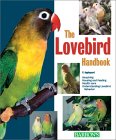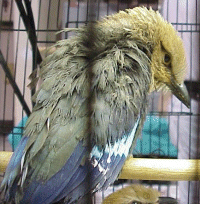Issues with Mixing Bird Species in the Home
Bono and Lissel seemed to get along perfectly. They groomed each other, chattered together as they drifted into a midafternoon nap, and often played with the same toys. Their owner loved to take photos of the pair playing together. It amazed him to see bird as big as Bono, a red-bellied parrot of the Poicephalus family, play with an adorable little spangled budgerigar. “What a funny odd couple!” he thought. That was until the day Lissel flew to him and he noticed his beak hanging at a strange angle.
It seems Bono had either gotten irritated with Lissel’s constant playing or had been a little overzealous while grooming the small parakeet. Needless to say, that beak about five times the size of Lissel’s beak did considerable damage to the poor little bird. Hundreds of dollars at the vet and a few days later, Lissel died due to complications. His owner was devastated. How could Bono kill this little bird he seemed to adore?
Letting different species interact might work on some occasions, but often there are risks involved that every owner should know about. Certain species are more aggressive than others; this is even true of the commonly peaceful families, such as finches. While society finches might be pleasant enough, there are some varieties of finches that would not share the same airspace in harmony. However, society and zebra finches generally live quite happily together.
The general rule of thumb is not to mix parrot-type birds with nonparrot species and not to mix parrot species that have large differences in beak size. However, in the case of many birds, it is an individual bird’s personal territoriality and aggressiveness that will determine if he or she can be safely allowed to sit on the same playstand as another bird. For example, my senegal Max is much smaller than my blue-fronted amazon Inca, but Inca is a peaceful bird and more bark than bite. Max hates other birds and will charge them if he can. He would easily injure the much larger Inca because she is a pushover and wouldn’t even think of defending herself. Max gets excited and agitated even when he hears Inca vocalizing in another room. Clearly these two could not share the same playtree or be in a situation where they could get to each other’s cages. Anyone with a senegal knows just how lethal that beak can be. A bite on a leg can be extremely serious and lead to amputation.
Remember that even if two different species of birds in your home seem completely compatible, this can change in a split second. If one is much larger than the other, the smaller one can be seriously or fatally injured before you even realize there is a problem. Many people put parakeets (budgerigars) in flights with finches. I would advise them not to keep these birds housed together. I have seen a finch killed by a little parakeet hen and it was not a pretty sight.
Three’s a Crowd
Even mixing birds of the same species can create problems. One of the most common mistakes I hear about is when someone puts three birds of the same species in a cage. Two of the birds gang up on one (usually the newest addition) and kill it. I hear of this sort of incident with lovebirds all the time. Three is a crowd for most parrot species, and probably for most nonparrot species where a pair has bonded. The third bird is seen as competition for one mate’s attention and/or for territory and food. Another common mistake is to add a bird to a cage where other pairs are currently breeding or keeping an odd number of birds in a breeding flight. In the case of budgerigars, the “spare” hens can become very aggressive toward hens with nestboxes, sometimes destroying their eggs or killing the hen in the nestbox.
In Conclusion
Be sure to thoroughly investigate the compatibility of different species with each other, even in the case of small finches. Never leave unsupervised different species of birds who are allowed to play in the same general area. Aggressive incidents most often occur when the owner walks out of the room for a moment. Take a good look at how your cages and play areas are arranged so different pets cannot get to each other on their own. These precautions will pay off in the long run by helping you avoid the sad fate of Lissel.










